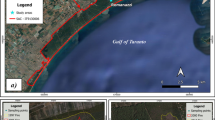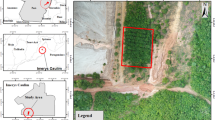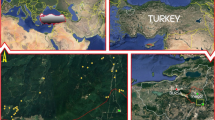Abstract
The results of studying the forest-growing properties of the iron-illuvial podzols under purposefully formed young Siberian stone pine (Pinus sibirica L.) forests are presented. The sufficient supply of these stands with moisture and the high content of nitrogen in the soils make the soils favorable for the regeneration, growth, and development of dark coniferous forests. The soils of the test objects exposed to sanitary cutting were compared to those under the control stand. The silvicultural procedures were shown to promote more efficient use of the soil resources by Siberian pine trees.
Similar content being viewed by others
References
Agrochemical Methods of Soil Examination, Ed. by A. V. Sokolov (Nauka, Moscow, 1976) [in Russian].
E. V. Arinushkina, Handbook on the Chemical Analysis of Soils (Mosk. Gos. Univ., Moscow, 1970) [in Russian].
I. A. Bekh, Cedar Forests in the Southern Ob’ River Region (Nauka, Novosibirsk, 1974) [in Russian].
I. A. Bekh and V. N. Vorob’ev, “Potential Cedar Forests,” in Problems of the Cedar (Ross. Akad. Nauk, Tomsk, 1998), No. 6 [in Russian].
A. F. Vadyunina and Z. A. Korchagina, Methods of Studying the Physical Properties of Soils (Agropromizdat, Moscow, 1986) [in Russian].
V. N. Vorob’ev, “Possible Solution of the Cedar Problem,” in Problems of the Cedar: Organization of Integrated Economy (Akad. Nauk SSSR, Tomsk, 1989), pp. 8–13 [in Russian].
S. M. Gorozhankina and V. D. Konstantinov, “Typification of Taiga Ecotopes with Account for Their Forest Resource Potential,” Geogr. Prir. Resur., No. 2, 132–135 (2002).
T. T. Efremova, S. P. Efremov, and V. P. Cherkashin, “Relationship of Bog Pine Forest Productivity with Soil Conditions in Western Siberia,” Lesovedenie, No. 2, 50–59 (1995).
L. O. Karpachevskii, Forest and Forest Soils (Lesnaya Promyshlennost’, Moscow, 1981) [in Russian].
I. S. Kaurichev, E. V. Kulakov, and E. M. Nozdrunova, “Formation and Migration of Iron-Organic Compounds in Soils,” Pochvovedenie, No. 12, 1–8 (1958).
Classification and Diagnostics of Russian Soils, Ed. by L. L. Shishov, V. D. Tonkonogov, I. I. Lebedeva, and M. I. Gerasimova (Oikumena, Smolensk, 2004) [in Russian].
N. F. Kozhevatova, “Renewal of Siberian Cedar under the Forest Canopy and on Conventionally Clean Areas in the Taiga Zone,” in Natural Renewal of Coniferous Plants in Western Siberia (Akad. Nauk SSSR, Novosibirsk, 1962), pp. 75–84 [in Russian].
V. N. Mina, “Effect of Rain Water Flowing down Tree Trunks on the Soil,” Pochvovedenie, No. 10, 44–52 (1967).
V. N. Mina, “Leaching of Some Substances by Atmospheric Precipitation from Woody Plants and Its Significance in the Biological Cycle,” Pochvovedenie, No. 6, 7–17 (1965).
A. V. Ogorodnikov, S. F. Polyakov, I. N. Rosnovskii, and Yu. A. Dunovskii, An Instrument for Measuring the Redox Potential of Soil (IPP-10): Information Sheet No. 143-89 (Tomsk, 1989) [in Russian].
V. S. Panevin, “Cedar Cultures in Tomsk Oblast,” in Problems of the Cedar (Ross. Akad. Nauk, Tomsk, 1989), pp. 81–86 [in Russian].
V. S. Panevin, V. N. Vorob’ev, E. G. Paramonov, et al., Problems of the Cedar: Organization of Resource Use and Reproduction (Akad. Nauk SSSR, Tomsk, 1989) [in Russian].
N. I. P’yavchenko, “Mineral Nitrogen Nutrition of Forest Plants and Drainage Reclamation,” in Proceedings of the All-Union Workshop on the Nutrition of Woody Plants and Increase of Plantation Productivity (Petrozavodsk, 1969), pp. 7–9 [in Russian].
A. A. Rode, “Field Water Capacity,” Pochvovedenie, No. 12, 43–53 (1968).
B. G. Rozanov, Soil Morphology (Mosk. Gos. Univ., Moscow, 1983) [in Russian].
S. N. Sannikov and N. S. Sannikova, “Forest as an Underground-Closed Forest Ecosystem,” in Stationary Forest-Ecological Studies: Methods, Results, and Outlooks: Proceedings of the International Conference, Syktyvkar, Russia, 2003) (Syktyvkar, 2003), p. 133 [in Russian].
N. K. Talantsev, A. N. Pryazhnikov, and N. P. Mishukov, Cedar Forests (Lesnaya Promyshlennost’, Moscow, 1978) [in Russian].
Author information
Authors and Affiliations
Additional information
Original Russian Text © O.Yu. Chitorkina, V.V. Chitorkin, 2007, published in Pochvovedenie, 2007, No. 3, pp. 338–342.
Rights and permissions
About this article
Cite this article
Chitorkina, O.Y., Chitorkin, V.V. Forest-growing properties of soils under young Siberian stone pine (Pinus sibirica) forests in Western Siberia. Eurasian Soil Sc. 40, 308–312 (2007). https://doi.org/10.1134/S106422930703009X
Received:
Issue Date:
DOI: https://doi.org/10.1134/S106422930703009X




